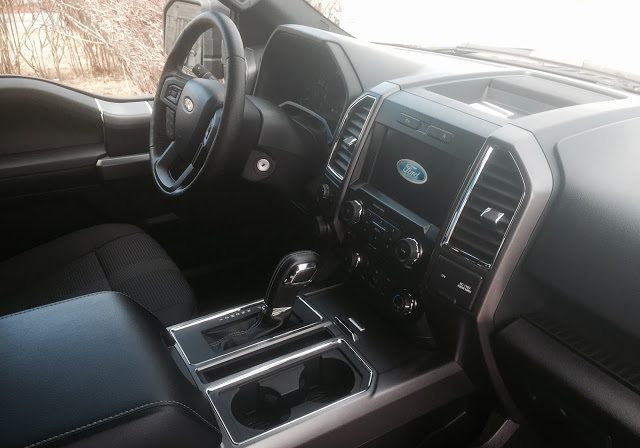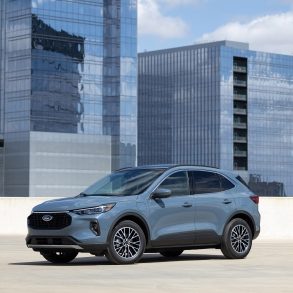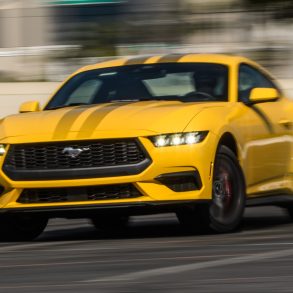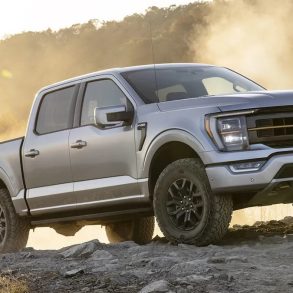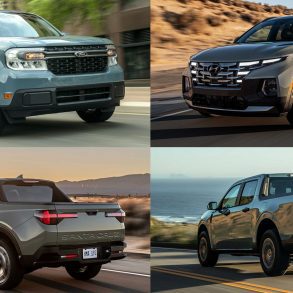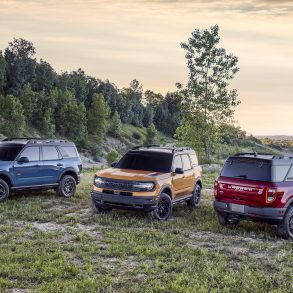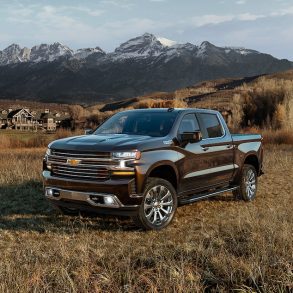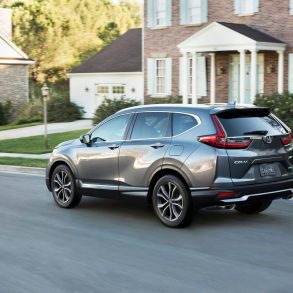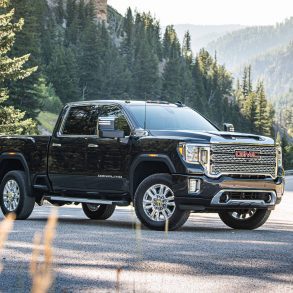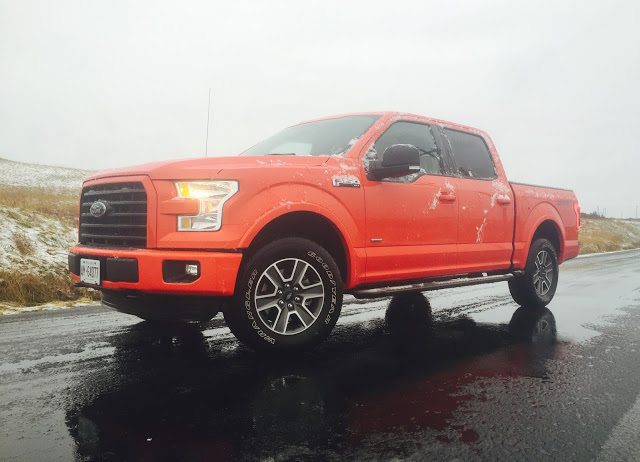
It’s the best-selling example of the best-selling vehicle line in North America, the SuperCrew 4×4 F-150 from Ford’s dominant F-Series line.
Canadians are on track to buy more F-Series’ pickup trucks in 2016 than at any point in history. U.S. F-Series sales climbed to a nine-year high in 2015 and are ahead of last year’s pace by 5%, a gain of nearly 9000 sales over the span of only three months.
Moreover, nearly two-thirds of F-150s are now sold with EcoBoost V6 engines. In the 12th-generation truck, an EcoBoost badge meant one thing: a 3.5L twin-turbo. Now in its 13th-generation, the Ford F-150 offers two twin-turbocharged V6 EcoBoost engines.
| THE GOOD • Shockingly mighty 2.7L turbo V6 • Gigantic rear seat • Simple tech interface • Composed ride and handling • Amazing resale value |
THE BAD
• E’erybody’s got one
• Not a huge fuel economy benefit
• Sounds like a vacuum • Huge dead zone in steering • Mushy brakes |
We reviewed a 3.5L-equipped model late last year. Calling it BoostEco, we were suitably impressed with the powerplant but unsure if the luxury intent of the F-150 Platinum was let down by that high-end truck’s flinty ride on 20-inch wheels with the FX4 off-road suspension.
This 2016 Ford F-150 XLT Sport SuperCrew 4×4 EcoBoost is better.
 The 18-inch wheels and standard suspension play a role in its superiority. Ride quality is much improved. The addition of SYNC3, which isn’t the best infotainment unit on the market but is also far from the worst, modernizes the cabin.
The 18-inch wheels and standard suspension play a role in its superiority. Ride quality is much improved. The addition of SYNC3, which isn’t the best infotainment unit on the market but is also far from the worst, modernizes the cabin.
But in truth, it really all comes down to this F-150’s smaller DOHC, 24-valve, 2.7L twin-turbocharged V6 “Nano” engine.
|
2016 FORD F-150 SUPERCREW
4×4 XLT ECOBOOST 2.7 Base Price: $44,649 * As-Tested Price: $58,729 * Drive Type: four-wheel-drive Transmission: 6-speed automatic Engine: 2.7L DOHC 24-valve twin-turbocharged V6
Horsepower: 325 @ 5750 rpm Torque: 375 lb-ft @ 3000 rpm Curb Weight: 4782 pounds
Length: 231.9 inches Width: 79.9 inches Height: 77.2 inches Wheelbase: 145.0 inches Tires: Goodyear Wrangler Fortitude HT 275/65R18 Passenger Volume: 3732 litres Cargo Volume: 1495 litres EPA City: 18 MPG EPA Highway: 23 MPG NRCAN OEE City: 13.1 L/100km
NRCAN OEE Hwy: 10.1 L/100km Observed: 19.4 mpg Observed: 12.1 L/100km * Canadian dollars, includes $1800 in fees. |
POWER
Hard as it may be to accept, we’re in a golden era for engine technology, and an automaker such as Ford can take a very small 2.7L V6 engine and tune it to make 325 horsepower and 375 lb-ft of torque.
Eight years ago, the F-150’s 5.4L V8 – twice the displacement and two additional cylinders – produced 25 fewer ponies and 10 fewer lb-ft of torque.
But the 2.7’s results are more astonishing than the power figures would lead you to believe.
The 2.7L EcoBoost does, after all, produce 40 fewer horses and 45 fewer lb-ft than the 3.5L EcoBoost V6.
Yet in Consumer Reports testing, the 2.7L EcoBoost F-150 was the quicker truck, accelerating from rest to 97 kmh in 7.0 seconds, two-tenths quicker than the 7.2 result for the 3.5L EcoBoost. Yes, you read that right.
In the real world, whether because of gearing or smaller wheels or the lighter curb weight of an XLT SuperCrew compared with our Platinum SuperCrew tester from last year, the 2.7L EcoBoost feels like the livelier machine. Not hugely so, but it’s happier to rev and marginally more cooperative with the 6-speed automatic.
CAPABILITY
There are sacrifices, however. With less power and torque, the 2.7L EcoBoost’s maximum payload in SuperCrew 4×4 form is 1960 pounds, 100 pounds shy of the equivalent 3.5L’s 2060-pound maximum payload rating.
Of greater note is the F-150 SuperCrew 4×4 3.5L EcoBoost’s maximum towing capacity of 11,500 pounds, 3500 more than the 2.7L can manage.
Yet it must be said that, while the 3.5L EcoBoost F-150 can surely tow 11,500 pounds – and likely more with relative ease – regular long-term towing in that weight class is a task better completed by one of the F-150’s SuperDuty brethren or the F-250/F-350’s HD rivals from General Motors or Ram.
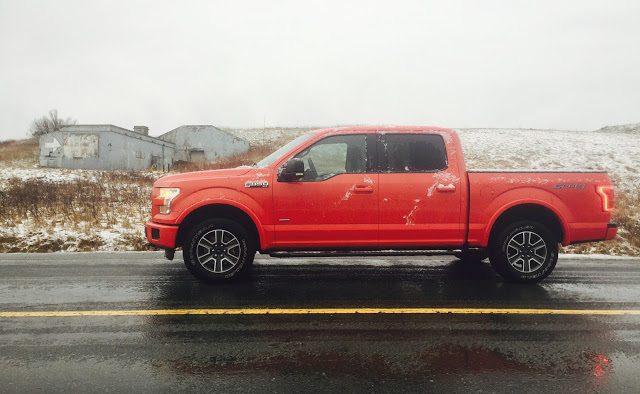 |
| All Photo Credits © Timothy Cain Click Any image For A Larger View |
FUEL
The 2.7L is therefore not technically as powerful as the 3.5L, but it feels every bit as quick. It can’t carry or tow quite as much as the 3.5L, but it’s no shrinking violet in the RV park.
But the impetus behind Ford’s development of a small turbocharged V6 F-150 was the idea of mixing similar power with improved efficiency.
In our week-long tests, an F-150 3.5L EcoBoost SuperCrew Platinum 4×4 with a 3.31 rear end drank 13.2 litres of gasoline for every 100 kilometres of a mostly urban mix of city and highway driving just as winter dawned.
Four months later, as winter lingered in early April, this F-150 2.7L EcoBoost SuperCrew XLT 4×4 with a 3.55 rear axle finished the week with a 12.1 L/100km result.
Historical Monthly & Yearly Ford F-Series Sales Figures
2015 Ford F-150 Platinum EcoBoost 3.5L SuperCrew 4×4 Driven Review
2015 Ram 1500 EcoDiesel Outdoorsman 4×4 Quad Cab Driven Review
2015 GMC Sierra 4×4 Crew Cab SLT 6.2L Driven Review
No two tests are identical. The 2.7L was likely exposed to a lower average temperature but also benefited from additional highway time. The 3.5L wore the aforementioned 20-inch wheels and Hancook Dynapro AT-m tires; this 2.7L was on 18-inch Goodyear Wrangler Fortitude HTs. Perhaps due to the HVAC system’s frequent use, the smooth auto stop-start function on the 2.7L didn’t do a whole lot of auto stopping.
Regardless, our results are in keeping with the disparity in official EPA and Natural Resources Canada ratings and not entirely out of whack in comparison to real world results on Fuelly.com.
And yet, the 10% improvement from the F-150 2.7L EcoBoost may not be quite as financially rewarding as you’d like, depending on your mileage. Over the course of 20,000 annual kilometres at 12.1 L/100km and with Halifax fuel prices at $1.02/L, the 2.7L EcoBoost will cost $206 per month. In the same circumstances, the 3.5L truck will cost $224 per month.
By the standards of a car buyer who’s trying to figure out if a basic Elantra is less costly than a basic Civic, $18 is not nothing. On the other hand, $18 is about what you spend on Tim Hortons coffee on the way to work each month.
PRICE
Pair $18 in fuel savings together with the lower cost of the 2.7L EcoBoost, however, and the monetary argument becomes much stronger. Optioning up your F-150 to include a 2.7L EcoBoost isn’t cheap – the naturally aspirated 3.5L V6 is $1300 less expensive. But from the 2.7L on up, the costs escalate at a similar rate: $900 more for the 5.0L V8 or $1400 more for the 3.5L EcoBoost V6.
If you’re saving $18/month on fuel, or about $1080 over the life of a five-year payment plan, plus another $1400 saved by avoiding the 3.5L EcoBoost in order to get an equally thrusty 2016 Ford F-150, the 2.7L stands out as the best engine in the F-150 family. Job done.
Now you’re just left to do the math on the Ram 1500 EcoDiesel. Or allow us to do it for you.
Timothy Cain is the founder of GoodCarBadCar.net, which obsesses over the free and frequent publication of U.S. and Canadian auto sales figures. Follow on Twitter @goodcarbadcar and on Facebook. The F-150 was supplied by Ford Canada’s press office.


